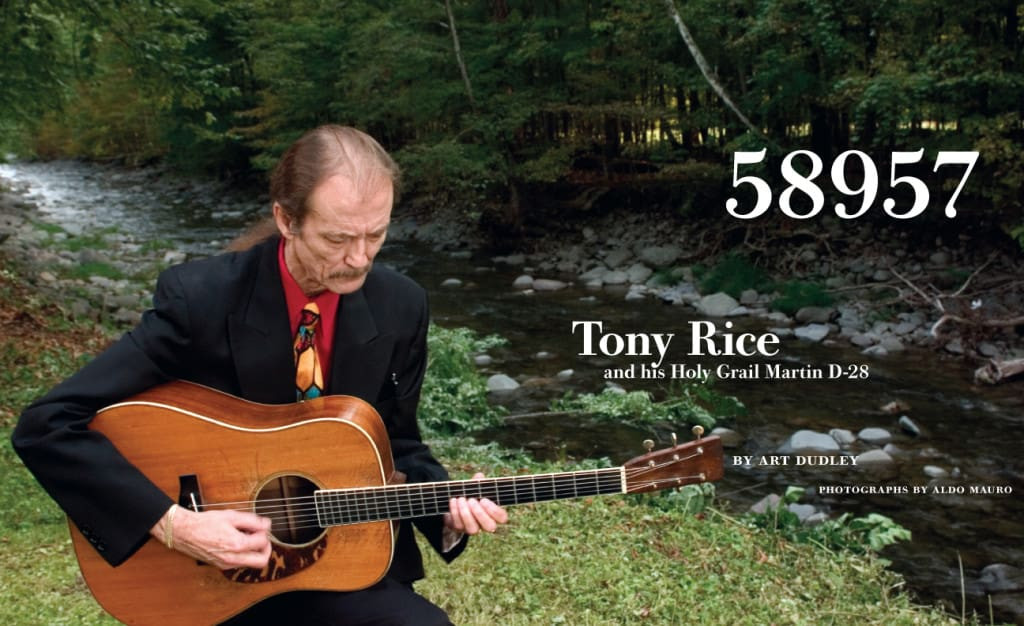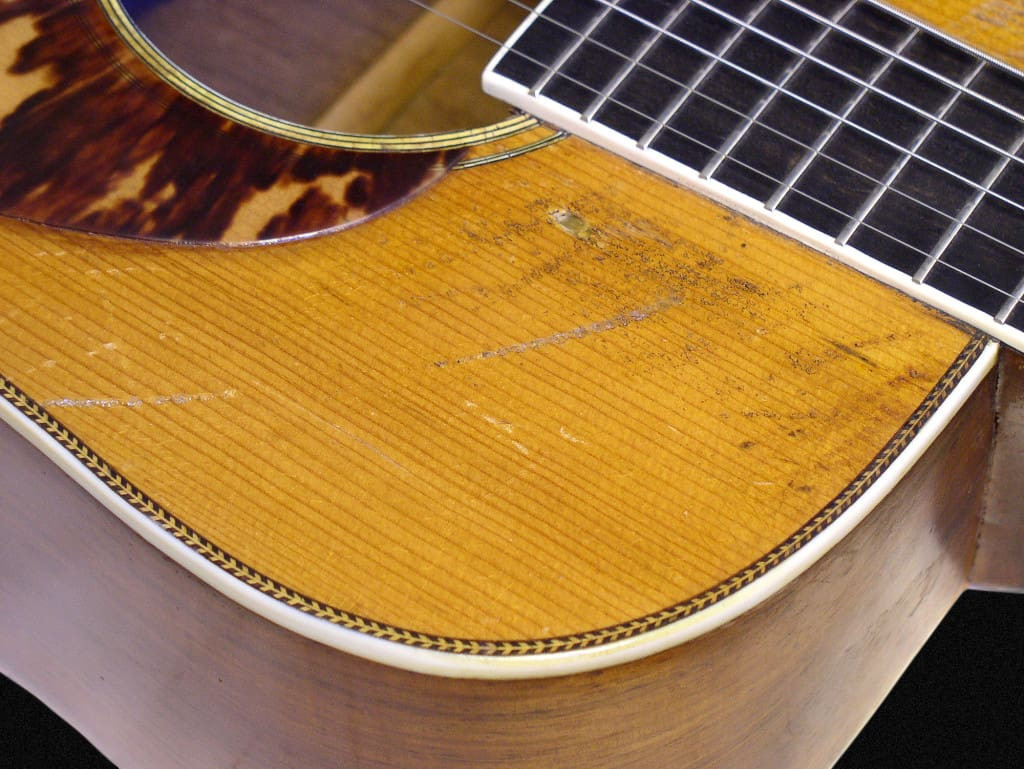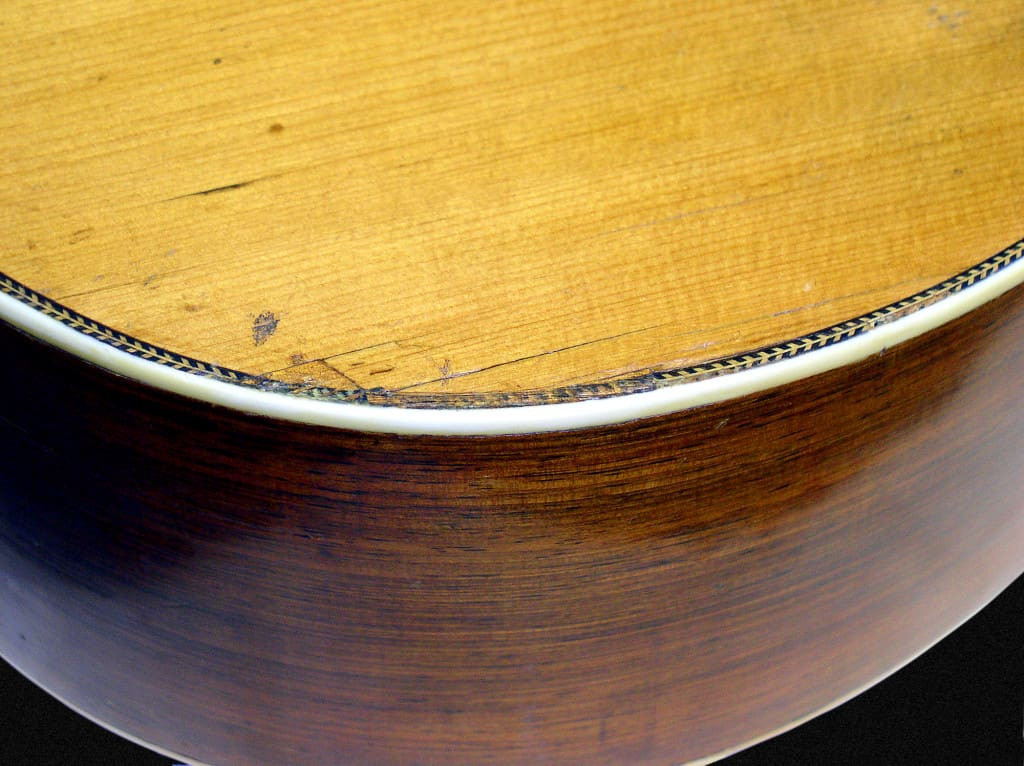The year was 1935, just weeks into a snowy January, and within the C.F. Martin Guitar Company in Nazareth, Pennsylvania, a new batch of rosewood dreadnought guitars was taking shape. Among them, bearing the serial number 58957, was a guitar destined for an extraordinary journey, one that would intertwine with the evolution of bluegrass music and become known as the Tony Rice Guitar, a veritable Holy Grail for musicians and vintage instrument aficionados alike. This is the story of that legendary Martin D-28.
 Tony Rice playing his iconic 1935 Martin D-28 guitar
Tony Rice playing his iconic 1935 Martin D-28 guitar
From Nazareth Workshop to Bluegrass Legend
The meticulous craftsmanship at Martin in 1935 is vividly detailed in their production logs. From foreman John Deichman initiating the build of twelve rosewood dreadnoughts to the careful selection of Brazilian rosewood sides drying in the factory attic, each step was a testament to Martin’s century-long legacy. Serial number 58957 began as a mahogany neck block stamped “D-28” and “58957,” quickly becoming part of a 14-fret dreadnought body – a relatively new design at the time. Kerfed linings, two-piece tops and backs, and herringbone purfling, carefully taped and glued, all contributed to the guitar’s nascent form.
The neck, crafted in the style 28 tradition with diamond volutes, was precisely fitted to the body bearing the 58957 neck block. A steel T-bar, possibly repurposed from sled-blade stock, reinforced the neck, topped with a slotted fingerboard. Shaping the neck was an art in itself, using drawknives, rasps, files, and sandpaper, guided by metal templates to achieve the desired profile and diamond carving. After sanding, fretting, staining of the Brazilian rosewood and mahogany, and multiple lacquer coats, serial number 58957 was strung, cased, and shipped approximately two months after its initial workshop order. At this point, its story disappears from record, only to resurface decades later in a Los Angeles music store.
The White Brothers’ $25 Treasure
In 1959, young bluegrass musicians Roland and Clarence White, accompanied by bandmate Billy Ray Lathum, were instrument hunting in Los Angeles. Their father, Eric White Sr., a seasoned picker himself, often sought pre-war Martins, intending to refurbish and resell them. This time, however, 15-year-old Clarence was searching for his D-28. Pawn shop after pawn shop yielded nothing affordable. Then, in a music store corner, amidst repair projects, sat 58957. For a mere $25, they acquired the 1935 herringbone Martin D-28 in as-is condition.
The guitar was rough. An amateur had drastically enlarged the soundhole, cutting into the rosette. The original fingerboard was gone, replaced temporarily with a taped-on ebony board. The pickguard was peeling. Eric White Sr. initially deemed it “hopeless.” Undeterred, Roland and Clarence took their Martin to Milt Owen, a luthier who would later become known as Hollywood’s “guru of guitar repair.” Owen offered a more optimistic assessment. While the soundhole was irreparable, he found a suitable fingerboard – a white, plastic-bound Gretsch blank with 22 frets, surprisingly close in scale to a Martin dreadnought. The repair cost matched the guitar’s purchase price, but the White brothers proceeded. A week later, they retrieved their D-28, strung with light-gauge strings, sounding remarkably good. Owen cautioned against heavier gauges, but the young Clarence White, known for pushing boundaries, eventually disregarded this advice.
 The top of Tony Rice's 1935 Martin D-28 guitar, showcasing its aged spruce and modifications
The top of Tony Rice's 1935 Martin D-28 guitar, showcasing its aged spruce and modifications
Clarence White’s Revolution and a Young Tony Rice
Clarence White’s ownership of this modified Martin D-28 marked a turning point in bluegrass guitar playing. While the White family owned other fine instruments, including a newer 1952 Martin D-18, the herringbone D-28 became Clarence’s signature guitar. Its unique voice, despite its battered condition and increasingly high action, became synonymous with his groundbreaking style.
In 1960, a pivotal encounter occurred. Nine-year-old Tony Rice, newly arrived in Southern California and playing in his family band, saw the guitar backstage at a radio show. Rice recalls, “It was the first time I’d appeared anywhere. I saw that old D-28, and it didn’t have a name on the headstock, so I asked, ‘What kind of a guitar is that?’ and Clarence said, ‘It’s a Martin.’ I’d never seen one like that. I thought all dreadnoughts were D-18s! So I asked, ‘Is that a D-18?’ He said, ‘No, that’s a D-28.’ I’d never heard of a D-28. The only thing I knew was that it looked like hell but it sounded like a million bucks to a 9-year-old kid!” Clarence White allowed the young Rice to play the guitar, despite its challenging action. This encounter, though seemingly small, planted a seed in young Tony Rice’s mind.
As Clarence White’s reputation grew with the Country Boys and later the Kentucky Colonels, his frustration with the D-28’s playability also increased. In a moment of youthful indiscretion, Clarence leaned the guitar against a tree and shot it with a pellet gun, leaving a visible scar it bears to this day. Accidents seemed to follow the instrument. After a gig, Clarence even ran over both his Martins with the band van. While the D-18 suffered more damage, the D-28 also sustained cracks, requiring repair by Herb David.
Passing into Legend: From Clarence White to Tony Rice
In 1965, financial realities forced Clarence White to part with the D-28. To fund a Fender Telecaster and honeymoon, he used the herringbone as collateral for a loan from Joe Miller. Clarence and the guitar would never be reunited. Tragically, Clarence White passed away in 1973.
By 1975, Tony Rice was making his own mark in bluegrass, playing with the Bluegrass Alliance and J.D. Crowe’s New South. While with Crowe, Rice worked alongside Bobby Slone, a former Kentucky Colonels fiddler. Slone recounted to Rice the story of Clarence White and Joe Miller. Intrigued, Rice tracked down Joe Miller through a remarkable series of phone calls to Miller’s Liquor stores in Pasadena, California.
Rice contacted Miller and inquired about the guitar. Miller confirmed he still had it, untouched for nine years under his bed. When Rice asked about selling, Miller agreed, but insisted on an appraisal. Expecting a hefty price tag, Rice braced himself for a bank loan. However, the appraiser at a violin shop, coincidentally the last place Clarence had the guitar repaired, valued it lower than expected due to its condition. Joe Miller called Rice back, stating, “I’ll take five or six hundred bucks for it.” Rice countered with $550, and the deal was struck. Tony Rice flew to Los Angeles and acquired the legendary herringbone Tony Rice guitar for a mere $550. “I kept waiting to wake up,” Rice later recalled, marveling at the ease of acquiring such a significant instrument.
 Close-up of the repair on the upper bout of Tony Rice's Martin D-28, a testament to its storied past
Close-up of the repair on the upper bout of Tony Rice's Martin D-28, a testament to its storied past
A Lifelong Partnership and Continuous Care
Despite owning the legendary Tony Rice guitar, playing it initially presented challenges. Rice described the action as “like a Dobro.” However, its tone was immediately captivating. Remarkably, on the very day he acquired it, Rice found himself in a recording session with David Grisman for James Taylor’s Gorilla album, showcasing the guitar’s voice immediately.
Soon after acquiring the guitar, Rice had the neck reset by Randy Wood. As the action gradually rose again, Richard Hoover, later co-founder of Santa Cruz Guitar Company, performed a “tweak reset,” a less invasive technique he now considers “horrifying” to contemplate on such a valuable instrument, but necessary at the time given the limited knowledge of neck resets. Hoover also reinforced the bridge plate with an ebony overlay, a repair originally done by Darol Anger.
Over the years, a cadre of renowned luthiers have contributed to the care of the Tony Rice guitar. Ervin Somogyi crafted bridge pins based on Clarence White’s originals. When a new bridge was needed, Mike Longworth of Martin personally selected old-stock wood, and Hideo Kamimoto expertly installed it, even seamlessly filling the old saddle slot. Todd Phillips added black position markers to the fretboard binding.
Perhaps the most dramatic incident occurred in 1993 when a tropical storm flooded Tony Rice’s Florida home, submerging the guitar for hours. Harry Sparks undertook the delicate process of slowly drying out the waterlogged Martin, mitigating further damage, though cracks to the back were unavoidable, and back bracing came loose. Snuffy Smith, a luthier near Rice’s North Carolina home, then reglued the internal bracing and has become the primary caretaker of the instrument for the last decade. Smith has performed fret jobs, reshaped the saddle, and even replaced a crucial top brace near the soundhole, utilizing an old brace intended for a 1941 D-18 sourced from Martin. He even managed to seamlessly repair the soundboard after removing and replacing the brace.
 A detailed shot of the lower bout repairs on Tony Rice's 1935 D-28, showcasing the herringbone inlay
A detailed shot of the lower bout repairs on Tony Rice's 1935 D-28, showcasing the herringbone inlay
The Voice of a Legend
Holding the Tony Rice guitar is a surprising experience. Its lightweight nature for a rosewood dreadnought is immediately noticeable. Inside, a rattlesnake rattle, a quirky addition, adds to its mystique. Playing it is often described as an unparalleled experience, like driving a Ferrari after Volkswagens. The guitar responds instantly, with incredible dynamic range and balance. Every note across its spectrum is clear and resonant. It’s not necessarily the loudest D-28, but it’s arguably the most expressive, possessing a unique voice that captivates any listener.
Measurements confirm its playability: string height around 6/64″ on the low E and 4/64″ on the high E at the 12th fret. The nut width is a vintage-spec 1 5/8″, with low string slots, yet expertly set up by Snuffy Smith to avoid buzzing. The string spacing at the bridge is 2 1/8″, ideal for Rice’s hand size.
When asked if he’d heard another flattop guitar comparable, Tony Rice cited Norman Blake’s 1934 D-28 and Eric Thompson’s herringbone as the closest contenders, but ultimately, his own 1935 Martin D-28 remains in a class of its own. “It’s still here,” Rice stated, a quiet acknowledgment of the instrument’s enduring presence in his life and music. Even “unwarmed up,” Rice could effortlessly draw a rich tapestry of sound from the guitar, transitioning into melodies like “Summertime,” demonstrating its inherent musicality.
The Holy Grail Endures
Tony Rice’s 1935 Martin D-28 is more than just a guitar; it’s a living artifact of musical history. Its journey from a Nazareth workshop to Clarence White’s revolutionary bluegrass to Tony Rice’s iconic sound is a testament to its enduring quality and unique voice. Maintained by some of the finest luthiers, bearing the scars of its adventures, and still inspiring awe in those who hear it, the Tony Rice guitar rightfully holds its place as a true Holy Grail of acoustic instruments. Its story continues, resonating with every note played and every tale told.
Editor’s note: This article originally appeared in the Fretboard Journal #5. For additional stories and videos featuring vintage (and new) Martins, explore more on Fretboard Journal.

